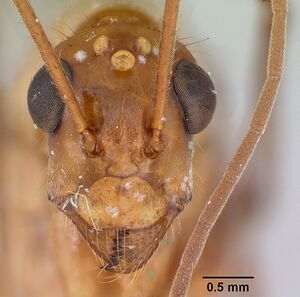Notostigma foreli
| Notostigma foreli | |
|---|---|

| |
| Scientific classification | |
| Kingdom: | Animalia |
| Phylum: | Arthropoda |
| Class: | Insecta |
| Order: | Hymenoptera |
| Family: | Formicidae |
| Subfamily: | Formicinae |
| Tribe: | Melophorini |
| Genus: | Notostigma |
| Species: | N. foreli |
| Binomial name | |
| Notostigma foreli Emery, 1920 | |
Taylor (1992) - Notostigma foreli workers are solitary, nocturnal foragers. The soil excavated from a nest may form a pronounced symmetrical cone, about 0.3 m high, surrounding the open summit entrance. The raised, reddish local sub-soil often makes these very easily seen. During the day above-ground effort to disturb the ants is typically ineffectual, but at night large numbers of workers may be present on the mound surfaces.
Identification
N. foreli is relatively large as a non-myrmeciine ant, but it is smaller than Notostigma carazzii. Head width in the largest workers is about 4 mm, and the occipital border is at most only feebly concave in frontal view, even in the largest workers. The ground colour is dull golden brown, with the head slightly, but usually distinctly darker.
Keys including this Species
Distribution
N. foreli is found in south-eastern Queensland and north-eastern New South Wales, and seems to be restricted to rainforest.
Latitudinal Distribution Pattern
Latitudinal Range: -17.60611° to -31.75°.
| North Temperate |
North Subtropical |
Tropical | South Subtropical |
South Temperate |
- Source: AntMaps
Distribution based on Regional Taxon Lists
Australasian Region: Australia (type locality).
Distribution based on AntMaps
Distribution based on AntWeb specimens
Check data from AntWeb
Countries Occupied
| Number of countries occupied by this species based on AntWiki Regional Taxon Lists. In general, fewer countries occupied indicates a narrower range, while more countries indicates a more widespread species. |

|
Estimated Abundance
| Relative abundance based on number of AntMaps records per species (this species within the purple bar). Fewer records (to the left) indicates a less abundant/encountered species while more records (to the right) indicates more abundant/encountered species. |

|
Biology
Castes
Images from AntWeb

| |
| Worker. Specimen code casent0102088. Photographer April Nobile, uploaded by California Academy of Sciences. | Owned by MSNG, Genoa, Italy. |
     
| |
| Queen (alate/dealate). Specimen code casent0172067. Photographer April Nobile, uploaded by California Academy of Sciences. | Owned by ANIC, Canberra, Australia. |
   
| |
| Worker. Specimen code casent0172068. Photographer April Nobile, uploaded by California Academy of Sciences. | Owned by ANIC, Canberra, Australia. |
    
| |
| Male (alate). Specimen code casent0172070. Photographer April Nobile, uploaded by California Academy of Sciences. | Owned by ANIC, Canberra, Australia. |
Nomenclature
The following information is derived from Barry Bolton's Online Catalogue of the Ants of the World.
- foreli. Notostigma foreli Emery, 1920b: 253 (w.q.m.) AUSTRALIA.
Type Material
- Syntype, worker(s), queen(s), male(s), New South Wales, Australia, Museo Civico di Storia Naturale, Genoa.
Unless otherwise noted the text for the remainder of this section is reported from the publication that includes the original description.
Description
References
- Cantone S. 2018. Winged Ants, The queen. Dichotomous key to genera of winged female ants in the World. The Wings of Ants: morphological and systematic relationships (self-published).
- Emery, C. 1920b. Le genre Camponotus Mayr. Nouvel essai de la subdivision en sous-genres. Rev. Zool. Afr. (Bruss.) 8: 229-260 (page 253, worker, queen, male described)
- Taylor, R. W. 1992a. Nomenclature and distribution of some Australian and New Guinean ants of the subfamily Formicinae (Hymenoptera: Formicidae). J. Aust. Entomol. Soc. 31:57-69.
References based on Global Ant Biodiversity Informatics
- Taylor R. W. 1992. Nomenclature and distribution of some Australian and New Guinean ants of the subfamily Formicinae (Hymenoptera: Formicidae). Journal of the Australian Entomological Society 31: 57-69.



